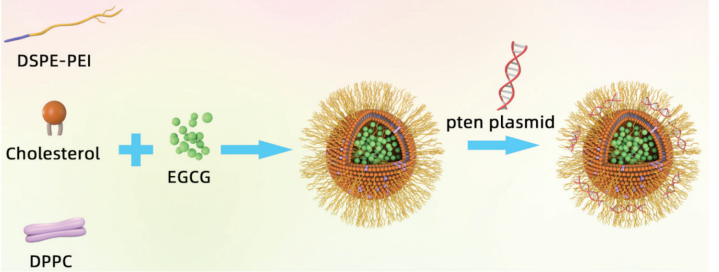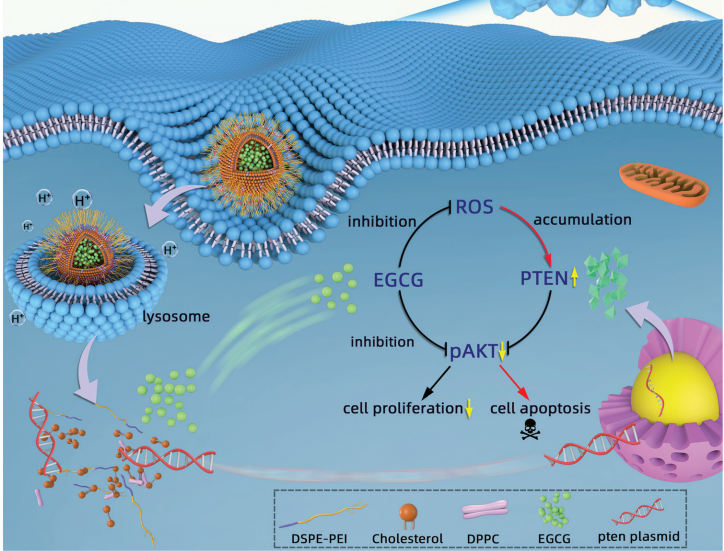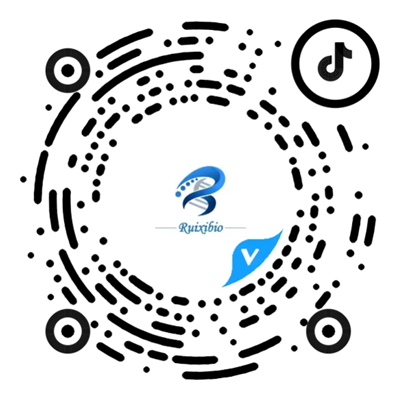文献:Self-responsive co-delivery system for remodeling tumor intracellular microenvironment to promote PTEN-mediated anti-tumor therapy
文献链接:
作者:Yifei Wang,Ruiting Wang,Sixuan Wu,Jingyi An,Yan Liang,Lin Hou and Zhenzhong Zhang
原文摘要:Delivering the pten gene into tumor cells to reacquire PTEN functionality is considered to be an attractive method for cancer treatment. However, the inhibition effect of the tumor intracellular microenvironment (TIME), especially at the high reactive oxygen species (ROS) level, on pten expression and PTEN protein functionality was nearly overlooked. Herein, the development of a potential strategy is described, which enhances PTEN-mediated anti-tumor capability by exhausting the intracellular ROS in TIME. To achieve this, poly(ethyleneimine) (PEI)-modified DSPE was introduced to protect the pten plasmid, and form liposomes for encapsulating the “scavenger” of oxidation homeostasis, epigallocatechin-3-gallate (EGCG).Notably, this was a simple system with improved safety compared which when compared with the use of PEI could accomplish efficient pten transfection and simultaneous disintegration to cause transient release of EGCG responding to the endosome environment through the “proton sponge effect”. In the cytoplasm, EGCG depleted ROS and promoted the expression of the pten gene as well as restoring protein functionality, thus negatively regulating the PI3K–AKT signaling pathway. In vitro and in vivo results revealed that this system significantly inhibited tumor growth via remodeling of the TIME, and provided a promising way to control malignant tumors.
DSPE-PEI由具有良好生物相容性和助于形成稳定纳米结构的 DSPE,以及具备DNA 结合能力和阳离子特性的 PEI 两部分组成。DSPE-PEI 应用于基因传递和化合物递送领域,作为基因传递载体,能安全地将外源基因导入细胞;作为化合物递送系统,可与负电荷化合物相互作用实现靶向Treatment 。该文献描述了一种策略——通过耗尽时间内的细胞内ROS来增强PTEN介导的抗tumor能力。引入了聚(乙烯亚胺)(PEI)修饰的DSPE来保护pten质粒,并形成脂质体来封装氧化稳态的“清除剂”,表没食子儿茶素-3-没食子酸酯(EGCG)。过程如下:

图:LEPP的合成工艺方案
LP@EGCG的准备
采用薄膜分散法制备了DPPC/CH/DSPE-PEI的阳离子LPs。简单地说,将DPPC/CH/DSPE-PEI脂质混合物在室温下分散在EGCG溶液中,将含有脂质的有机溶剂溶液置于旋转蒸发仪中。旋转蒸发仪在减压和旋转的条件下,使有机溶剂快速蒸发。在这个过程中,随着有机溶剂的不断挥发,脂质分子在烧瓶内壁逐渐聚集,最终形成一层均匀的脂质薄膜。向形成脂质薄膜的烧瓶中加入预先准备好的水性介质,脂质薄膜会逐渐吸水膨胀,从烧瓶内壁脱落下来,形成多层脂质体(MLV)。,对多层脂质体进行超声处理或通过挤压等方法使其进一步破碎和分散。然后,用去离子水透析溶液,以去除未封装的EGCG。将阳离子LSs和pten质粒溶液混合,然后在室温下孵育。

图:LEPP介导的细胞内ROS消耗和增强PTEN表达
结论:与使用PEI相比,DSPE-PEI参与制备的LP@EGCG可以通过实现pten转染和同时解体,通过“质子海绵效应”导致EGCG对核内体环境响应的短暂释放。在细胞质中,EGCG耗尽ROS,促进pten基因的表达,恢复蛋白功能,从而负调控PI3K-AKT信号通路。体内外实验结果显示,该系统通过重构TIME抑制tumor生长。

 2025-08-07 作者:ZJ 来源:
2025-08-07 作者:ZJ 来源:

